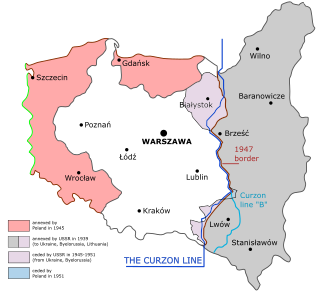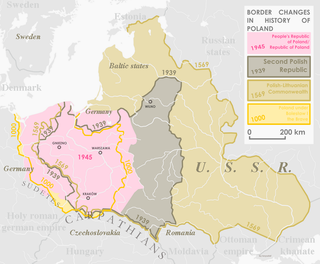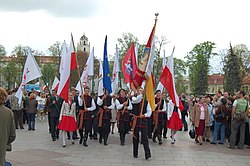
The Republic of Central Lithuania, commonly known as the Central Lithuania, and the Middle Lithuania, was an unrecognized short-lived puppet republic of Poland, that existed from 1920 to 1922. It was founded on 12 October 1920, after Żeligowski's Mutiny, when soldiers of the Polish Army, mainly the 1st Lithuanian–Belarusian Infantry Division under Lucjan Żeligowski, fully supported by the Polish air force, cavalry and artillery, attacked Lithuania. It was incorporated into Poland on 18 April 1922.

Eastern Borderlands or simply Borderlands was a term coined for the eastern part of the Second Polish Republic during the interwar period (1918–1939). Largely agricultural and extensively multi-ethnic with a Polish minority, it amounted to nearly half of the territory of interwar Poland. Historically situated in the eastern Polish–Lithuanian Commonwealth, following the 18th-century foreign partitions it was divided between the Empires of Russia and Austria-Hungary, and ceded to Poland in 1921 after the Treaty of Riga. As a result of the post-World War II border changes, all of the territory was ceded to the USSR, and none of it is in modern Poland.

Polonization or Polonisation is the acquisition or imposition of elements of Polish culture, in particular the Polish language. This happened in some historic periods among non-Polish populations in territories controlled by or substantially under the influence of Poland.
The city of Vilnius, now the capital of Lithuania, and its surrounding region has been under various states. The Vilnius Region has been part of the Grand Duchy of Lithuania from the Lithuanian state's founding in the late Middle Ages to its destruction in 1795, i.e. five centuries. From then, the region was occupied by the Russian Empire until 1915, when the German Empire invaded it. After 1918 and throughout the Lithuanian Wars of Independence, Vilnius was disputed between the Republic of Lithuania and the Second Polish Republic. After the city was seized by the Republic of Central Lithuania with Żeligowski's Mutiny, the city was part of Poland throughout the Interwar period. Regardless, Lithuania claimed Vilnius as its capital. During World War II, the city changed hands many times, and the German occupation resulting in the destruction of Jews in Lithuania. From 1945 to 1990, Vilnius was the Lithuanian Soviet Socialist Republic's capital. From the dissolution of the Soviet Union, Vilnius has been part of Lithuania.
The city of Vilnius, the capital and largest city of Lithuania, has an extensive history starting from the Stone Age. Vilnius was the head of the Grand Duchy of Lithuania until 1795, even during the Polish–Lithuanian Commonwealth. The city has changed hands many times between Imperial and Soviet Russia, Napoleonic France, Imperial and Nazi Germany, Interwar Poland, and Lithuania. It was especially often the site of conflict after the end of World War I and during World War II. It officially became the capital of independent, modern-day Lithuania when the Soviet Union recognized the country's independence in August 1991.

Vilnius Region is the territory in present-day Lithuania and Belarus that was originally inhabited by ethnic Baltic tribes and was a part of Lithuania proper, but came under East Slavic and Polish cultural influences over time.

Zigmas Zinkevičius was a Lithuanian academician, baltist, linguist, linguistic historian, dialectologist, politician, and the former Minister of Education and Science of Lithuania (1996–1998). Zinkevičius authored over a hundred books, including the popular six-volume "History of the Lithuanian language" (1984–1994), and over a thousand articles, both in Lithuanian and other languages. He was an academician of the Lithuanian Catholic Academy of Science since 1991 and a full member of the Lithuanian Academy of Sciences from 1990 to 2011, when he became an emeritus member.
Vilnija is a Lithuanian cultural and political organization, created to promote and preserve Lithuanian culture in Vilnius region, the Lithuanian name after which the organization is named. Due to its anti-Polish sentiment the organization has been described as extremist and nationalist.
The Lithuanian minority in Poland consists of 8,000 people living chiefly in the Podlaskie Voivodeship, in the north-eastern part of Poland. The Lithuanian embassy in Poland notes that there are about 15,000 people in Poland of Lithuanian ancestry.
Lithuanization is a process of cultural assimilation, where Lithuanian culture or its language is voluntarily or forcibly adopted.

Poland and Lithuania established diplomatic relations from the 13th century, after the Grand Duchy of Lithuania under Mindaugas acquired some of the territory of Rus' and thus established a border with the then-fragmented Kingdom of Poland. Polish–Lithuanian relations subsequently improved, ultimately leading to a personal union between the two states. From the mid-16th to the late-18th century Poland and Lithuania merged to form the Polish–Lithuanian Commonwealth, a state that was dissolved following their partition by Austria, Prussia and Russia. After the two states regained independence following the First World War, Polish–Lithuanian relations steadily worsened due to rising nationalist sentiments. Competing claims to the Vilnius region led to armed conflict and deteriorating relations in the interwar period. During the Second World War Polish and Lithuanian territories were occupied by both the Soviet Union and Nazi Germany, but relations between Poles and Lithuanians remained hostile. Following the end of World War II, both Poland and Lithuania found themselves in the Eastern Bloc, Poland as a Soviet satellite state, Lithuania as a Soviet republic. With the fall of communism relations between the two countries were reestablished. Since then relations have been friendly and akin to strategic partnership in defence and security.
Union of Poles in Lithuania is an organization formed in 1989 to bring together members of Polish minority in Lithuania. It numbers between 6,000 to 11,000 members. It defends the civil rights of the Polish minority and engages in educational, cultural and economic activities. It is the largest Polish organization in Lithuania, and was created in 1990.

The Polish minority in Belarus numbers officially 288,000 according to 2019 census. However, according to the Ministry of Foreign Affairs of Poland the number is as high as 1,100,000. It forms the second largest ethnic minority in the country after the Russians, at around 3.1% of the total population. An estimated 205,200 Belarusian Poles live in large agglomerations and 82,493 in smaller settlements, with the number of women exceeding the number of men by 33,905. Some estimates by Polish non-governmental sources in the U.S. are higher, citing the previous poll held in 1989 under the Soviet authorities with 413,000 Poles recorded.

The Polish population transfers in 1944–1946 from the eastern half of prewar Poland, were the forced migrations of Poles toward the end and in the aftermath of World War II. These were the result of a Soviet Union policy that had been ratified by the main Allies of World War II. Similarly, the Soviet Union had enforced policies between 1939 and 1941 which targeted and expelled ethnic Poles residing in the Soviet zone of occupation following the Nazi-Soviet invasion of Poland. The second wave of expulsions resulted from the retaking of Poland from the Wehrmacht by the Red Army. The USSR took over territory for its western republics.

The Polish-Lithuanian identity describes individuals and groups with histories in the Polish–Lithuanian Commonwealth or with close connections to its culture. This federation, formally established by the 1569 Union of Lublin between the Kingdom of Poland and Grand Duchy of Lithuania, created a multi-ethnic and multi-confessional state founded on the binding powers of national identity and shared culture rather than ethnicity or religious affiliation. The term Polish-Lithuanian has been used to describe various groups residing in the Commonwealth, including those that did not share the Polish or Lithuanian ethnicity nor their predominant Roman Catholic faith.
Jan Ciechanowicz was a Polish Lithuanian politician who was an ethnic Polish member of the Supreme Soviet of the USSR (1989–1991).
Polish autonomy in the Vilnius Region was an idea about a politically autonomous territorial unit for Poles in Lithuania, which began to be discussed in autumn 1988, when Lithuania was regaining its independence from the Soviet Union. As a result of perestroika, under the influence of their own national revival, and also fearing an attempt at Lithuanianization in independent Lithuania, Poles in Lithuania attempted to protect their own cultural identity by establishing autonomy. According to the Polish sociologist Adam Bobryk, this project never gained full support from the Lithuanian authorities, nor was implemented unilaterally by the Poles. The project was subject to several years of discussion and design work in 1988–1991, various groups of the Polish minority differed about its ultimate shape, basically agreeing only that autonomy should cover areas where Poles are the majority, and the Polish language should be given equal status.
The population exchange between Poland and Soviet Lithuania at the end of World War II (1944-1947) was based on an agreement signed on 9 September 1944 by the Lithuanian SSR with the newly-formed Polish Committee of National Liberation (PKWN). It stipulated the resettlement of ethnic Lithuanians from Poland to Lithuania and of ethnic Poles and Jews who had Polish citizenship before 17 September 1939 from Lithuania to Poland, in accordance with the resolutions of the Yalta and Tehran conferences and the plans about the new Lithuania–Poland border. Similar agreements were signed with the Ukrainian SSR and the Byelorussian SSR ; the three documents are commonly known as the Republican Agreements.
The History of Poles in Lithuania describes the history of Polish culture and language in Lithuanian lands, as well as the process of formation in the Polish community there before 1990.
Jan Sienkiewicz, is a Lithuanian publicist of Polish ethnicity, journalist, translator, activist of the Polish minority in Lithuania, member of the Lithuanian Seimas from 1997 to 2000.














